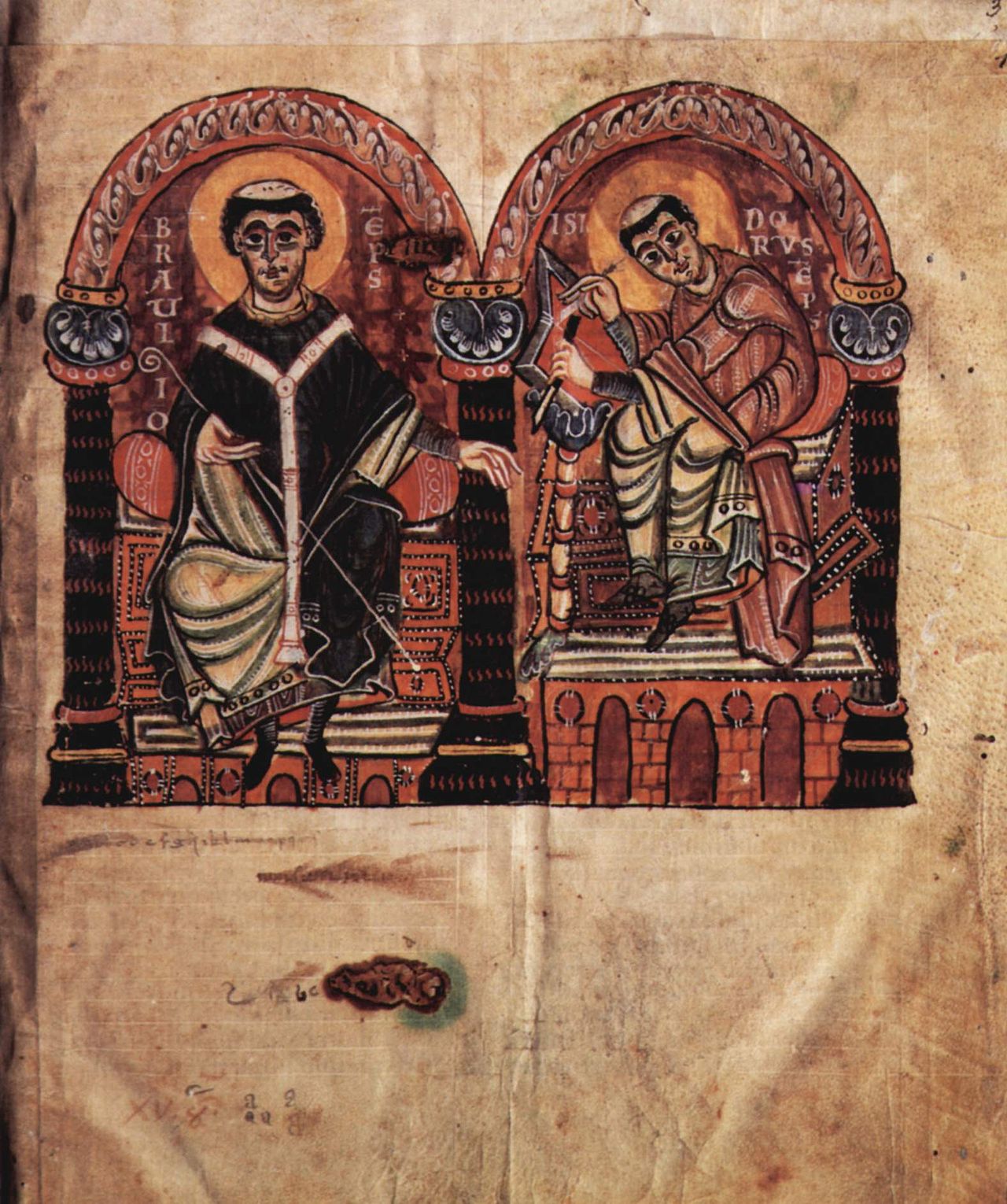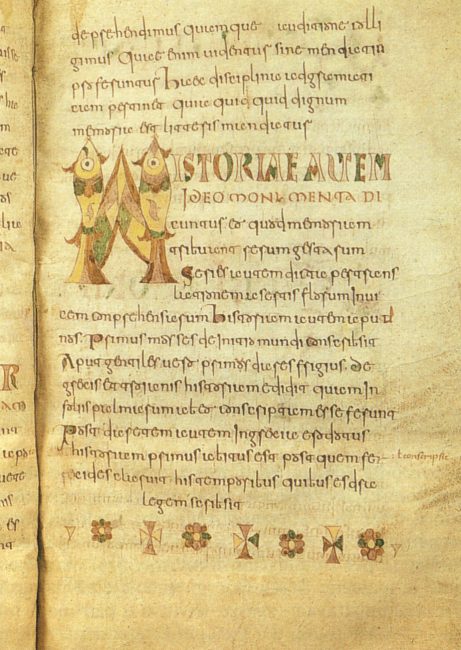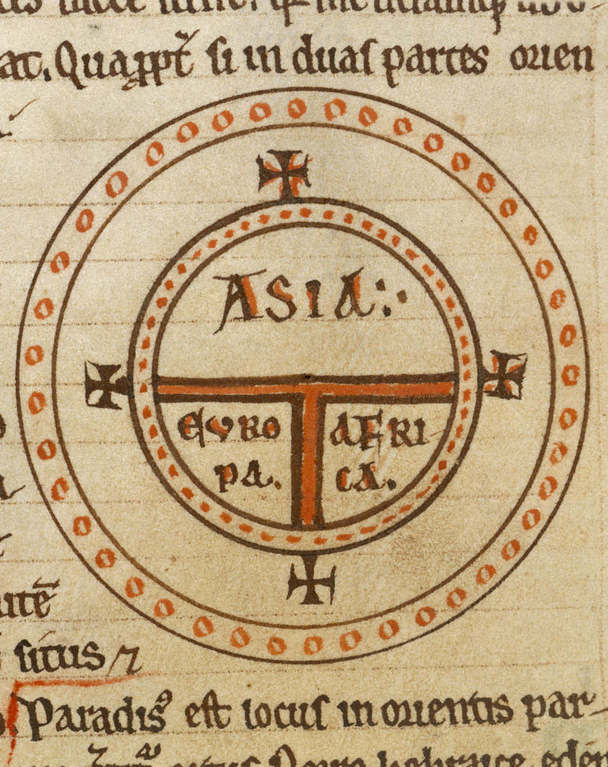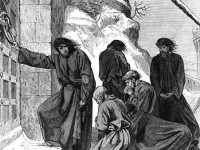
Isidore (right) and Braulio (left) in an Ottonian illuminated manuscript from the 2nd half of the 10th century
On April 4, 636, Saint Isidore of Seville, Archbishop of Seville, passed away. He is referred to as “the last scholar of the ancient world. In his Encyclopaedia Etymologiarum sive originum libri XX he compiled the knowledge of antiquity still existing in the west of the Mediterranean around 600 CE, combined it with patristics and made it available to his time. Isidor was one of the most widely read authors of the Middle Ages.
“And without music there can be no perfect knowledge, for there is nothing without it. For even the universe itself is said to have been put together with a certain harmony of sounds, and the very heavens revolve under the guidance of harmony.”
– Isidore of Seville, Etymologia
Isidore of Seville – Early Years
Isidore was born around 560 CE in Cartagena, Spain (Iberia), a former Carthaginian colony, to Severianus and Theodora. Both Severianus and Theodora belonged to notable Hispano-Roman families of high social rank. By the time of Isidore’s birth, Iberia was already for two centuries under Gothic control, who incrementally suppressed the ancient institutions, classic learning, and manners of the Roman Empire. The associated culture entered a period of long-term decline. The ruling Visigoths nevertheless showed some respect for the outward trappings of Roman culture. Arianism meanwhile took deep root among the Visigoths as the form of Christianity that they received. Left an orphan while still young, Isidore was educated in the Cathedral school of Seville, and soon distinguished himself in controversies with the Arians. In this institution, the first of its kind in Iberia, a body of learned men including Archbishop Leander of Seville taught the trivium and quadrivium, the classic liberal arts. Isidore applied himself to study diligently enough that he quickly mastered Latin, and acquired some Greek, and Hebrew.
Archbishop of Seville
After the death of his brother in 599 CE, Isidor was chosen Archbishop of Seville (Hispalis), an office he held for more than 30 years. In 619 CE he presided over a synod under the Visigoth king Sisebut (to whom he also dedicated his Etymologiae), and in 633 CE he chaired the 4th Imperial Council of Toledo under King Sisenand. Isidor of Seville was one of the most important writers and scholars of the early Middle Ages and can also be counted among the last authors of late antiquity, because he collected and ordered the ancient knowledge still available. The Hispanic Visigothic Empire was at its time characterized by the mixing of Roman and Germanic culture. Moreover, parts of the Iberian Peninsula – including Isidor’s birthplace Cartagena – were temporarily under the control of the Eastern Roman Emperor after the middle of the 6th century, which facilitated access to ancient works.

A page of Etymologiae, Carolingian manuscript (8th century), Brussels, Royal Library of Belgium
The Etymologiae
“Many creatures go through a natural change and by decay pass into different forms, as bees [are formed] by the decaying flesh of calves, as beetles from horses, locusts from mules, scorpions from crabs.”
– Isidore of Seville, Etymologia
Isidore wrote his writings in Latin as the “striking capstone of Latin antiquity“. He dealt with very different fields of knowledge and left a large number of works. Isidor’s Encyclopaedia Etymologiarum sive originum libri XX (short: Etymologiae), which comprises 20 books, is particularly well known. King Sisebut, to whom it is dedicated in the preface, died already in 621, but the work was still unfinished 15 years later when Isidore died and was only arranged and published by his pupil Braulio. With this work, Isidore left his mark on the knowledge of his epoch right up to the early modern period; the first three books, which dealt with the literary trivium (grammar, rhetoric, dialectics) and the mathematical quadrivium (arithmetic, geometry, astronomy and music), were particularly effective. In this way Isidore laid the foundation for every higher education in the Middle Ages. Others of his rediscoveries, such as the ancient atomic theory, initially received no attention.
The Shape of the Earth
Isidore’s cosmographic explanations in chapters 3-6 and in chapter 8 on the mountains of the XIVth book; in the XIIIth book the chapters on oceans, seas, gulfs and others on waters and in the XVth book on cities, exerted a lasting influence on medieval cartography. His geographical indications are preceded in the XIVth book by explanations about the circularity of the earth and its T-shaped division. The interpretation of these sentences is controversial: Some people think that he thought the earth was a disk, others argue that he meant only the inhabited part of the earth by the “circularity”.

The medieval T-O map represents the inhabited world as described by Isidore in his Etymologiae.
Medical Sciences
The independent chapter De Medicina, describes philosophy and medicine (secunda philosophia) as disciplines that encompass the whole person. In this chapter, Isidore discusses the history and detailed tasks of medicine. In order to practice medicine, the physician must be trained in all subjects of the trivium and quadrivium, even if medicine itself does not belong to the artes liberales.
Legacy
“Letters are signs of things, symbols of words, whose power is so great that without a voice they speak to us the words of the absent; for they introduce words by the eye, not by the ear.”
– Isidore of Seville, Etymologia
Isidore was undoubtedly the greatest man of his time in the church of Spain. He was versed in all the learning of the age, and well acquainted with Greek, Latin, and Hebrew. His works show him as a man of varied accomplishments and great versatility of mind; and the prominent place he long filled in his own country sufficiently indicates his general ability and character. His eloquence struck all who heard him with astonishment, and he represented in himself all the science of his time. His language is studiously scriptural. He is quoted as holding predestinarian views, but his language seems hardly to go so far. At the 8th council of Toledo in 653 CE, the epithet Egregius was applied to him, and confirmed at the 15th council of Toledo, 688 CE.[1] Isidor’s writings were eagerly copied by monks in the Middle Ages. Some statements of ancient authors are known only through his quotations. His work had an enormous influence on the following generations, both through his bible exegesis and because of his transmission of ancient knowledge to the world of the Middle Ages.
The Science of Etymology
“And without music there can be no perfect knowledge, for there is nothing without it. For even the universe itself is said to have been put together with a certain harmony of sounds, and the very heavens revolve under the guidance of harmony.”
– Isidore of Seville, Etymologia
Of the highest general importance for the construction of realities in the next 1000 years was his “invention” of a universally applicable method of explaining the world by means of truth-finding through language, which he called etymology. He understood etymology differently from modern linguistics. Isidore’s etymology procedure, which gave his main work its title, can be paraphrased in a shortened form as follows: “If you want to find something true about the object designated by the word in a word, then check the origin of the object, or its effect or the opposite of it on whether you find linguistic and/or factual/contental similarities between word and thing. An insight into the essence of a concept gained “etymologically” in this way is considered to be more profound than insights gained in other ways (philosophical, scientific).
In 1598 Isidore was canonized. In 2001 he was about to become the patron saint of the Internet, but the Vatican has not yet proclaimed an official patron saint of the Internet.
The Etymologies of St. Isidore of Seville, [6]
References and Further Reading:
- [1] Isidorus, archbp. of Seville, in Dictionary of Christian Biography and Literature edited by Henry Wace and William Coleman Piercy
- [2] The Order of Saint Isidore of Seville, st-isidore.org
- [3] Jones, Peter. “Patron saint of the internet”, telegraph.co.uk, 27 August 2006 (Review of The Etymologies of Isidore of Seville, Cambridge University Press, 2006)
- [4] Works written by or about Isidore of Seville at Wikisource
- [5] Isidore of Seville at Wikidata
- [6] The Etymologies of St. Isidore of Seville, Trivium Takeout @ youtube
- [7] O’Connor, J.B. (1910). “St. Isidore of Seville“. Catholic Encyclopedia. Vol. 8.
- [8] Timeline of Etymologists, via DBpedia and Wikidata





